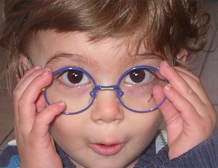Squint - when the visual axes of the two eyes are not aligned on the same object of interest. It is not the same as when short-sighted people screw up their eyes in order to see better. So, what are the implications of a squint, and what are the treatment options? Squint left untreated can lead to a permanent loss of vision.
What is Lazy eye or Amblyopia?
Myoping or 'screwing up the Eyes'

The word “squint” is often mis-used to mean screwing up the eyes; the technical term for this is actually “myoping”, since short sighted people can see a bit better if they screw up their eyes. Used correctly, the word squint means that the visual axes of the 2 eyes are not aligned on the same object of interest.
Broadly speaking, there are 2 sorts of squints; adult and child. They are quite different but to complicate matters, adult-type squint may occur very rarely in children, and child-type squint may manifest itself in adulthood. In general, squint in adults is caused by nerve damage and is associated with strokes. The squint may recover, but management is of the underlying medical condition and may include using prisms in spectacles until the final outcome is known. Careful management is required, and since adult squint causes double vision, patients will usually see an ophthalmologist quite quickly. In this article I am going to discuss the type of squint that occurs in children.
Why does a squint occur in children?
Whilst children are occasionally born with a squint (congenital squint), it is much more common for it to develop as a result of focussing problems around the age of 3 years. When we look at things that are close to us, two things must happen. We focus on the object to see it clearly, and our eyes converge or turn inwards so that they both point exactly at the object we wish to see. These two things, focussing and convergence are controlled by the brain in a very tightly linked fashion, making it difficult or impossible to do one without also doing the other.
A person who is short-sighted can only see things a short distance away but cannot see things in the far distance. Conversely, someone who is long-sightedcan see things a long distance away but not easily close up. An eye that is long-sighted is slightly too short for the focussing power of the front of the eye, and in order to obtain a clear image has to exert focussing power to see things clearly even when they are in the distance. This contrasts with a normal eye where no focussing is required to see distant objects clearly. Thus a child who is long-sighted will have to exert focussing power all the time and particularly for near objects, and because focussing and convergence are linked, the child may well end up over- converging or converging all the time, which produces the condition we call squint.
An eye that is squinting is not pointing at what the other eye is looking at and the effect of this is double vision. To stop the double vision, children actually "turn off" the vision in the squinting eye, and unless this is treated by the age of about 5, the eye will have the vision "turned off" permanently. This condition is called amblyopia or commonly "lazy eye". Although the eye might appear normal, it cannot see normally.
The usual treatment for a child with a squint is glasses, which aim to correct the long-sight and thereby the need to focus. They will therefore hopefully either abolish or reduce the squint. However, they must be worn at all times to be of any use.
Wearing a patch is also used to treat amblyopia. By covering the non-squinting eye, the squinting eye is "forced" to do the seeing and will therefore tend to relearn to see. As the squinting eye relearns to see, it sometimes looks as though it is the other eye that has started to squint. In fact this is a good sign as it means that the child is responding well to treatment. Patching is much more effective before the age of 5 years. Surgeryis not always the right treatment for squint and it is certainly not a "short cut".
Many children grow out of the need for glasses but not all. Many people are left with a degree of amblyopia but live normal and fulfilling lives. Cosmetic squint surgery is possible at any age, but treatment to improve vision is much less effective after the age of 5 years.
In summary, if you suspect your child has a squint then a proper ophthalmic assessment is required, as treatment needs to be started as soon as possible to get the best outcome.
Q. I’ve been told that children grow out of squint but is this correct?
A: This is not correct. However, an eye with poor vision tends to drift out, so an
un-treated squint may seem to improve cosmetically. However, the vision is lost permanently.
Q. I don’t like the idea of my child wearing glasses. Is this necessary?
A: Most parents would agree with this, but if the eye does not learn to see normally
by the age of 5 years then the prognosis is poor. Much better to wear glasses for a few years whilst a child and have good vision than to lose this opportunity.
Q. Why can’t we just have surgery straight away and get it over with?
A: Surgery is not a short cut. What matters is how well the eyes see, and just
aligning the eyes surgically will not address this. Perhaps needless to say, although
extremely safe, surgery always has its risks
